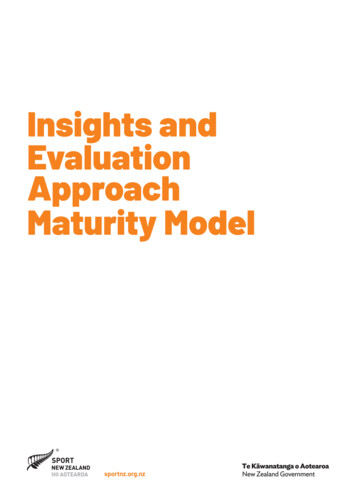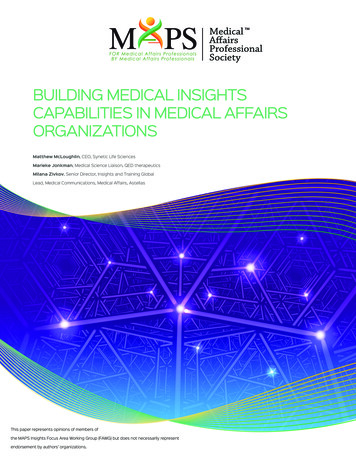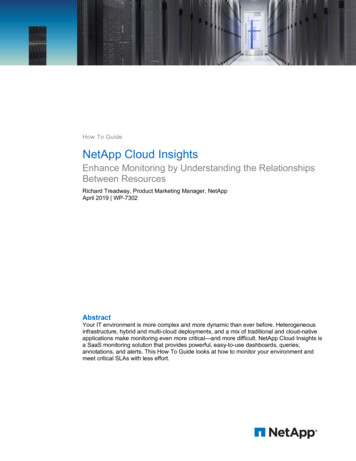
Transcription
Insights into Your Potentialas a WISE Leader:Self-Reflection & AssessmentDr. Betsy ShoenfeltDepartment of Psychological SciencesWestern Kentucky University
Dr. Betsy Shoenfelt,Department of Psychological Sciences Dissertation research on applied leadershipExecutive coaching for C-suite leaders and managing directorsProgram evaluation of leadership development program forCorporate VPs and Managing Directors for FedEx FreightDeveloped situational judgement test to assess 8 dimensions ofapplied leadership effectiveness Used by several leadership graduate programs & in longitudinal researchMultiple presentations at International Leadership Association onleadership assessmentSteering Committee for WKU Center for Leadership Excellence andLeadership Studies ProgramDeveloped and taught graduate level courses in leadership for Ed.D.in Educational Leadership and Leadership Studies & IndustrialOrganizational (IO) Psychology graduate programs
OverviewConceptualizing Leadership Reflection and Assessment LeadershipTraits Leadership Skills
Introduction toLeadership
Leadership DefinedLeadershipis a process whereby an individualinfluences a group of individuals toachieve a common goal.
Conceptualizing LeadershipEvolving theories leadership effectiveness: Personal traits or characteristics Leader Behavior Situationally-based: interaction betweenleader behavior and the situation Reciprocal influence between leaders &followers & situation Recent recognition of the importance oftraits
Assigned vs. Emergent LeadershipAssigned Leadership based onoccupying a positionwithin an organization Team leaders Managers Supervisors Directors Provosts, Deans,Department HeadsEmergent Individual perceived byothers as the most influentialmember of a group ororganization regardless of theindividual’s title Emerges over time throughbehavior and interactions Referent Power based onRespect & Trust Expertise/Knowledge “Servant” Leader
Leadership Theories:3 Points of Convergence1.Importance of Personal Characteristics2.Importance of Task Skills3.Importance of Effective InterpersonalRelationships
Leadership Theories: Points of Convergence1. Importance of Personal Characteristics There are no specific traits which are universallyassociated with effective leadership. Over 100 empirical studies of leader traits Although traits alone are not sufficient to make aleader successful, they are a precondition. Successful leaders must take certain actions to besuccessful. BUT – certain traits predisposesuccessful leaders to take appropriate actions.
The Evidence: Traits Do MatterTraits related to leader effectiveness include: Drive Desire to Lead Self-confidence Cognitive Ability Technical Knowledge Honesty/Integrity Tolerance for Stress Flexibility**Importance of different traits depends on the situation.
Leadership Theories: Points of Convergence2. Importance of Task Skills Muchof leadership involves guidingindividuals and groups to accomplishtasks Relevantskills: visioning, organizing,planning, problem solving, and innovation
Leadership Theories: Points of Convergence3. Importance of Effective Relationships Cooperativerelationships characterized byhigh levels of trust and loyalty Supportive behavior is likely to influencemember satisfaction - especially when difficulttask Relevant skills are consideration, team skills,communication, influence skills, andcharisma.
Leadership AssessmentSelf-reflection and insight into one’s ownstrengths and “areas for development” Evaluation and Feedback from others 360FeedbackSuperior Peers Subordinates/Clients/Customers Self Knowledge Tests Criterion-Referenced Measures Inventory ofLeadershipStrengths
Personal Characteristics forLeadership Effectiveness
S1. Drive Drive: high energy and effort directed towardaccomplishing identified goals Includes behaviors such as: Focusing on accomplishment of performance goalsDemonstrating a high energy levelExpressing a strong sense of urgency about finishing requiredtasksHelping the group move forwardUrging/pushing the group towards task completionDemonstrating tenacity in task accomplishmentDemonstrating perseverance when faced with obstaclesDemonstrating initiative in moving team toward taskaccomplishmentRate Yourself
S1. Drive Drive consists of a constellation of5 sub-traits and motives reflectinga high effort level Achievement Motivation Ambition Energy Tenacity Initiative
S2. Achievement Motivation Leaders have a high desire for achievementObtain satisfaction from:Completing challenging tasks Attaining standards of excellence Developing better ways to do things. Working their way up – leaders must have a desireto complete challenging assignmentsTom Watson at IBM – described as “driventhroughout by a personal determination to create acompany larger than NCR”Rate Yourself
S3. Ambition – desire to get aheadTo advance, leaders actively take steps todemonstrate their drive and determinationWalt Disney was described as having “doggeddetermination to succeed.” C.E. Woolman of Delta Airlines as “inexhaustibleambition.” In AT&T 20-year study, ambition/desire foradvancement was the strongest predictor ofsuccess 20 years later. Rate Yourself
S4. Energy –Physical, mental, and emotional vitality EffectiveLeaders:Have a high energy level and stamina Are active, lively, and often restless Even at age 70, Sam Walton, founder of Walmart,still attended Saturday morning, 7:30 am sales peprallies for 300 store managers. Rate Yourself
S5. Tenacity –Perseverance to overcome obstacles Effectiveleaders are:Able to overcome obstacles Strength of will or tenacity Tirelessly persistent in activities and follow throughwith their programs Ray Croc of McDonalds “Nothing in the world can take the placeof persistence . . . Talent will not; Genius will not; Education willnot. Persistence & determination alone are omnipotent.” Effective leaders use persistence intelligentlyDogged pursuit of an inappropriate strategy canruin an organizationRate Yourself
S6. Initiative Effectiveleaders are proactive Make choices and take action that leads tochange Instead of just reacting to events or waiting forthings to happen (“fire-fighting”), effective leadersanticipate and take action beforehand.Rate Yourself
S7. Leadership Motivation Desire to Lead The desire to influence and lead others Astronauts John Glenn & Frank Borman builtpolitical careers and businesses out their earlyfeats as space explorers – other astronautsdid not, even though they had the sameopportunities.Willingness to assume responsibility Can be equated with the need for power
S7. Leadership Motivation (continued) The Role of Power Power is the means through which the leadergets things done in an organizationEffective leaders give powers to others toincrease their own power See power as an “expandable pie,” not a fixed sumPower can be created and distributed to followers withoutdetracting from their own power – in fact, increases powerEffective leaders must be willing to exercise powerover members Tell them what to doAppropriately reward and use negative sanctions
Leadership Motivation(cont.)Two different types of power motivePersonalized PowerMotive:---Seeks power as an endin itself – lust for powerHave little self-controlOften impulsiveFocus on collectingsymbols of personalprestigeUse power to dominate& manipulate othersSocialized PowerMotive:----Uses power as a means toachieve desired goals orvisionEmotionally matureWilling to take advice fromexperts/less defensiveExercises power for thebenefit of the whole orgEmpowers followersRate Yourself
S8. Self-Confidence Being a leader is a difficult job Constant decision making and problem solving Followers have to be influenced Set backs have to be overcome Self-Confidence plays an important role in: Decision-makingGaining others’ trustEffective implementation of the decisionSelf-Confident leader can be more assertive anddecisive Projecting Self-confidence builds self-confidence in followers
Self-doubt prevents leaders from taking thenecessary actions to lead Hesitant in problem solving and decision makingFollowers less likely to trust leader and decisionLess effective in convincing followers to pursue courses ofactionLess effective in overcoming setbacksWhen a decision turns out to be a poor one, aself-confident leader Admits the mistakeUses it as a learning opportunity Jack Welch, legendary leader of General Electric Manager made 1 million mistakeRate Yourself
S9. Emotional Stability Emotional Stability Effectiveleaders remain even temperedGet excited But do NOT become angry or enraged Especially important when resolving interpersonalconflicts and representing the organization Consider stressful events Interesting Opportunities for development Believe they can influence the outcome Rate Yourself
S10. Cognitive Ability /Intelligence Leaders must formulate strategies, solveproblems, and make correct decisionsLeaders must gather, integrate, and interpretenormous amounts of information.A “keen mind” is needed (Kotter) Analytical ability, good judgment, capacity to thinkstrategically Followers look for intelligence in a leader. Source of authority in the leadership relationship.
S10. IntelligenceNot just conventional intelligence 2 key types of intelligence: intelligence – ability to recall,analyze, evaluate, and judge information Traditionalintelligence – ability to solveproblems by utilizing knowledge gained fromexperience to purposefully adapt to, shape,and select environments Practical
Practical intelligence is a core componentof leadershipknowledge – knowledge gained fromeveryday experience that has an implicit,unarticulated quality TacitLearning by doing, professional intuition, instinct,know how Tacit knowledge accounts for leadershipeffectiveness beyond traditional intelligence andother traits
S10. Intelligence / Creativity Creativity is skill in generating ideas that are: Relativelynovel High in quality Appropriate to the task at hand Important for leadership because leaders mustgenerate ideas others will follow Creative ideas include: Novel ideas Replications in a different application Redefinition of existing views Forward increments Redirections, regressive redirections Syntheses of ideas not previously integrated.
S10. Intelligence / Wisdom Wisdom consists of: Richfactual knowledge (general and specific) Rich procedural knowledge (general and specific) Knowledge about strategies and judgment Relativism – knowledge about differences in values,goals, and priorities Knowledge of the uncertainty and unpredictability ofevents and ways to manage this
A leader is wise to the extent s/he usesintelligence, creativity, and experience to: Seek a common goodVision beyond one’s self and immediate interests Balancingown, others, and organizationalinterests for which they are responsible Requires effort to understand others’ points of view Does this over the short- and long-termGreat deal of pressure to give in to short-termdemands that are damaging in the long runAdapts, shapes, and selects environments
S10. Synthesis of Intelligence A successful leader needs Creativeskills to generate new ideas Analytical skills to evaluate whether the ideasare good ones Practical skills to implement the ideas and topersuade others of the value of the ideasRate Yourself
S11. Technical Knowledge /Knowledge of the BusinessEffective leaders have a high degree ofknowledge about the organization,operations, performance, and technicalmatters.In-depth knowledge of the organization andindustry allows effective leaders to makewell-informed decisions and to understandthe implications of those decisions.Rate Yourself
Honesty/Integrity/EthicsIncludes behaviors such as: Demonstrating correspondence between word anddeed (“walks the talk”)Being truthful and non-deceitfulBeing open with followersBeing discreet and not violating confidencesActions are value-based and grounded on principle Decisions reflect values - even when challenged by peer pressure orauthorityBehavior reflects values - even when challenged by peer pressure orauthorityActing as a role model by personally acting in a mannerthat is consistent with shared values
S12./S13. Honesty and Integrity Integrity: The correspondence betweenword and deedHonesty: Being truthful or non-deceitfulHonesty and integrity lead to trustHonesty, integrity, and trust are essential Without these qualities, leadership isundermined.Rate Yourself
S14. Ethical BehaviorThe extent to which the individual does“the right thing” across situations andcircumstances, especially in difficult andchallenging situations. Behaving ethically is central to leadership Ethicalbehavior is defined by values Modeling the behavior that is expected ofemployees Reputation of the organization rests on ethicalRate Yourselfbehavior
S15. Courage Ability to make tough decisions and take difficultactions when needed Requires fortitude to defy the crowd Requires perseverance in the face of obstacles Requires a willingness to take sensible risksRate Yourself
S16. Tolerance for Stress Ability to maintain effectiveness in diverse situationsunder varying degrees of pressure, opposition, anddisappointment. Includes behaviors such as: Simultaneously dealing with multiple demands from multipleconstituenciesDealing with conflicting demandsDealing with too little time and too much to doDemonstrating resilience when faced with disappointments andsetbacksViewing obstacles as challenges rather than as road blocksManaging time and resources under demanding circumstancesDemonstrating high tolerance for ambiguityRate Yourself
S17. Flexibility/Adaptability Ability to adapt behavior to fit the situation. Seeswhat needs to be done and changeshis/her behavior to meet that needAdapting leadership style to the situation Providing more direction Assisting with the task Providing support Providing whatever it takes to keep the team ontrack and to maintain team relations Rate Yourself
Task Skills forLeadership Effectiveness
T1. VisioningAbility to create an image of the future for theunit/organization and develop the meansnecessary to achieve that image.Key actions: Create a Vision – concept of what the organizationshould beCommunicate the Vision - articulate through: Inspirational speechesWritten messagesAppeals to shared valuesActing as a role model (key)Promoting Change & Innovation - The vision is thestarting point of change
T1. Visioning: A Target that BeckonsIncludes behaviors such as: Articulating a credible, attractive future that isbetter in important ways Optimistic outlook about the futureDescribing the 'big picture‘Developing strategy for achieving the visionPresenting the vision with confidence andenthusiasmModeling actions consistent with the visionRate Yourself
T2. Organizing Ability to systematically arrange own work andresources, as well as that of others, for efficienttask accomplishment. Includes behaviors such as: Organizingpeople Organizing data Organizing things Providing structure to the work context Assigning tasks and role responsibilities Organizing work and scheduling work activitiesRate Yourself
T3. Planning Ability to anticipate and prepare for thefuture.Includes behaviors such as: Developing and stating action for future Incorporating time line into plan Setting performance standards Identifying and/or organizing appropriate, relevantresourcesRate Yourself
T4. Problem Solving Ability to: Gatherinformation Understand relevant technical andprofessional information Effectively analyze data and information Generate viable options, ideas, and solutions Select supportable courses of action
T4. Problem SolvingIncludes behaviors such as: Developing logical views, plans, or conclusions Integrating information from multiple sources Demonstrating an understanding of directives,instructions, or policies Paying attention to detail Gathering data/information Filtering irrelevant data Identifying trade-offs of alternative solutionsRate Yourself
T5. Innovation Ability to use available resources in newways; and to generate and recognizecreative solutionsIncludes behaviors such as: Developing innovative solutions Stimulating innovative thinking in others (e.g., askingthought-provoking questions) Supporting innovative thinking in others Promoting change and innovationRate Yourself
People Skills forLeadership Effectiveness
P1. Consideration Ability to consider the feelings and needs of others andbeing aware of the impact and implications of decisionsfor others; a sincere concern for group member’s needs Leader’s respect for ideas, trust, warmth towardmembers Relationship behaviors – Two-way communication Participation in decision making Rapport Respect, trust, & mutual liking between leaders &followersRate Yourself
P2. Team Skills Abilityto engage and work in collaborationwith other members of the group so thatothers are involved in the process and theoutcome The leader cannot do it alone Must select, train, & motivate skilled peoplewho work effectively together
P2. Team SkillsIncludes behaviors such as: Actively participating in the discussion or activityAcknowledging others' feelingsReinforcing or rewarding othersAccepting and using others' ideasWelcoming diverging viewsCompromising with other group membersInvolving others in the discussion/decision/activitySeeking consensusActively seeking contribution from other team membersDealing with conflictRate Yourself
P3. Communication Ability to effectively convey both oral and writteninformation, and to effectively respond to questions andchallenges. Includes behaviors such as: Presenting oral or written message in an organized mannerListening attentively to othersAnswering questions completely and appropriatelyPresenting material coherentlyPresenting ideas with confidence and convictionWritten communication accurately conveys relevant informationExpressing self in a manner that is easily understoodUsing effective physical aspects of communication Making effective eye contact; varying pitch of voice; speaking at acoherent rate; projecting voiceShowing excitement, enthusiasm, and charisma when presenting orlistening to othersUsing body language effectively ( e.g., posture, gestures, noddinginRate Yurselfonodding agreement, etc.)
P4. Influencing Others Ability to persuade others to do something oradopt a point of view in order to produce desiredresults (without creating hostility). Includes behaviors such as: Presentingcompelling arguments for a particularcourse of action Using clear rationale for the audience to follow his/herplan Impacting the direction that the group takes Influencing others by modeling his/her ownconvictionsRate Yourself
P5. Charisma A basis of power or influence grounded in follower’sperceptions that a leader is endowed with exceptionalpersonal qualities Ability to influence others to get them to adopt your values andbeliefsLess-clear cut evidence of importance for effective leadership More important in some contexts: e.g., politics, religionFollowers of Charismatic Leaders identify with the leaderand emulate him/her: Are emotionally attached to leaderNever question leader’s beliefs or actions;Unquestioning deep trust of leaderSee themselves as integral to the accomplishments of the leader’sgoalsReconceptualize importance of what they are doing to haveenduring or moral purposeFeel affection for the leader
Charismatic Leaders Strong need for powerSupremely confidentEngage in behaviors designed to impressfollowers (e.g., speak of own accomplishments)Articulate an appealing vision or sense of missionSet high goals for followers and expressconfidence in ability to accomplish those goalsAttempt to appeal to fundamental motives offollowers (e.g., need for power, need forachievement, need for affiliation), often throughinspirational speeches or writingsRate Yourself
Where do we go from here?
Application Provides direction to which traits are good tohave if one aspires to a leadership positionBy honestly answering the inventory . . . Candetermine whether one has leadership traits Can pinpoint strengths and weaknesses
Implications: Can leadership be learned? Traditional intelligence is the least trainableDrive is fairly constant; observableDesire to lead may be present early in career, butmay develop over timeSelf-Confidence comes from success experiencesKnowledge of the “Business” can be developedthrough experience and trainingHonesty/Integrity is a virtue one achieves or rejectsby choicePotential leaders can learn to/choose to engage ineffective behavior
Who is/will be a Leader? An individual may have leadership skills –but never exercise themA leader may have skills – but may beunwilling to use them for a common goodAn individual may want to be a leader, butlack traits or skillsAssessment will help you determine strengthsand weaknesses leadership potential
Questions?
Examples of Leadership Situations and Leader Behavior Please write 2 examples of leadership. Do NOT use specific namesor entities. Your examples should be written in generic terms.Successful Leadership1. Think of a time when a leader was particularly effective in facilitatingyour career in academics. On the form, write a description of thesituation, the behavior that was effective, and why the behavior was soeffective. Include the ABC’s: Antecedent / Situation: What was happening? What were relevantfactors that came into play? What information is needed to understandthe situation? (2 to 4 sentences)Behavior: What did the leader do that was so effective? Describe interms of behavior.Consequence (Why behavior was effective): Explain why thebehavior was so effective. What were the positive outcomes from theleader’s behavior?
Unsuccessful Leadership2. Now think of a time when a leader was particularly ineffective, thatis, the leader created a “barrier” or additional “hurdle” to yourcareer. On the form, write a description of the behavior that was noteffective, and why the behavior was ineffective: Include the ABC’s: Antecedent / Situation: What was happening? What were relevantfactors that came into play? What information is needed tounderstand the situation?Behavior: What did the leader do that was so ineffective? Describein terms of behavior.Consequence (Why behavior was ineffective): Explain why thebehavior was ineffective. What were the negative outcomes from theleader’s behavior? Please write at least one example of Leadership that facilitated andone example of Leadership that created a barrier. Thank you.
Questions?
Creativity is skill in generating ideas that are: Relatively novel High in quality Appropriate to the task at hand Important for leadership because leaders must generate ideas others will follow Creative ideas include: Novel ideas Replications in a different application Redefinition of existing views Forward increments




![2 CHAPTER 1 [Topic 1] Coulomb's law, electrostatic field and electric .](/img/52/physics.jpg)






